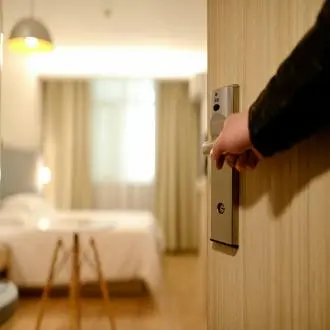Transcription equipment,machinery,toolsandequipment:maintenanceandsafety
Professional and efficient cleaning in a hotel establishment requires the use of a wide range of equipment, from basic hand tools to specialized machinery.
The objective of its use is to eliminate dirt and microorganisms to maintain a clean environment, prevent infections, and ensure hygiene and comfort throughout the facility.
Classification and Applications of Cleaning Machinery
Cleaning machinery saves a great deal of time and makes even the toughest jobs easier. Each machine is designed for a specific application:
- Vacuum cleaners: These are used to clean dust from all types of surfaces, achieving a deep cleaning by absorbing dirt. Wet vacuum cleaners are specifically used for cleaning carpeted floors.
- Scrubber-polisher-buffer: This is a versatile machine used to wax or glaze floors. Use different brushes or discs to perfect the shine.
- Rotary: Equipped with abrasive discs, these machines are used to strip floors, removing layers of wax or old crystallization. They can also scrub and degrease any type of floor.
- Crystallizers: These are essential machines for the care and shine of floors such as marble, terrazzo, or granite, leaving a crystallized, non-slip finish.
- Sweepers: Suitable for cleaning interiors and spaces with obstacles.
- Steam cleaning machines: These use high-temperature steam to clean and disinfect all types of surfaces, from tiles and toilets to windows and blinds.
Manual Cleaning Tools and Supplies
Along with machinery, manual tools are still indispensable for daily work:
- Broom, feather duster, brush, and dustpan: Essential for collecting dust and surface dirt.
- Bucket and mop: Essential for scrubbing floors.
- Sponges and scouring pads: These are used to clean different surfaces, often in combination with other products.
- Cloths, rags, and cloths: They have multiple uses, such as cleaning glass, dusting, or drying surfaces.
- Mop: A very useful tool for easily removing dust and stains from the floor.
- Rubber gloves: A key piece of personal protection to avoid direct contact with chemicals and protect your skin.
Equipment Maintenance and Cleaning
For all these tools and machines to have a long lifespan and offer maximum performance, proper maintenance and cleaning is crucial.
The manufacturer's instructions should always be followed.
Vacuum cleaners should be cleaned daily, including their nozzles and cable.
Scrubbers and polishers should be superficially cleaned every day, and their brushes should be thoroughly washed from time to time.
Brooms and mops should be washed periodically and allowed to dry properly so that they do not become deformed or accumulate bacteria.
The Cloths and rags should be kept clean and dry daily, as moisture encourages the growth of germs, and disinfected weekly.
Safety Rules for Using Equipment
The use of these tools and machines involves certain risks, so it is imperative to follow safety rules.
First, the risks must be identified, which include falls, awkward postures, or electrical contact.
Then, preventative measures must be applied. Each worker must be responsible for the equipment they use.
Electrical equipment should never be used while wet or with wet hands, and it should always be unplugged before cleaning.
It is crucial to check the condition of the handles and grips, discarding any that are damaged, and take special care when picking up broken glass, always using a brush and protective gloves.
Summary
Professional cleaning uses machinery such as vacuum cleaners or polishers for heavy-duty work. These are complemented by essential hand tools such as brooms, mops, cloths, and gloves.
Proper maintenance and cleaning are crucial to ensure the longevity of the equipment. Machines such as vacuum cleaners are cleaned daily, and hand tools are washed periodically.
Handling equipment entails risks, so safety regulations must be followed. Electrical appliances should never be used wet and should always be unplugged before cleaning.
equipment machinery utilities and tools maintenance and safety




